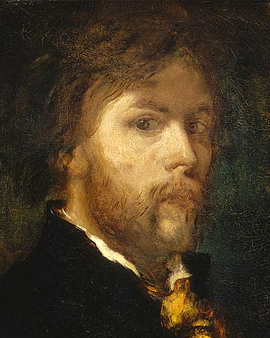In art, the period between 1880 and 1910 is described as the heyday of symbolism. It is an important current in sculpture and painting, which deals with the access to unconscious processes. This was already relevant before Freud's time. The "Symbolic Manifesto" summarized the movement as follows: "The essential characteristic of Symbolist art is that an idea is never fixed conceptually or expressed directly. The painter, engraver, draftsman and sculptor of this epoch, Gustave Moreau (*1826 in Paris - † 1898 in Paris), who had a decisive influence on Symbolism, concentrated in his works on mystical representations and dream scenes. Gustave Moreau, who had studied at the "École nationale supérieure des Beaux-Arts", undertook numerous trips to Italy to meet artists and see works in the original. Friends who were close to him were the painter Théodore Chassériau and the sculptor and painter Edgar Degas.
His artistic importance is today expressed in a museum in the 9th arrondissement of Paris, the "Musée national Gustave Moreau", where his life's work is documented and his works are made accessible to the public.
Gustave Moreau was of fragile health and did not immediately win prizes for his works. Nevertheless his theme and style prevailed. Above all in painting he made a name for himself. In paintings such as "Oedipus and the Sphinx", the figures and their surroundings are clearly recognizable, but elements are shown that are unreal. He executes the unreal as if it were real. Thus he emphasizes other levels of consciousness as part of our reality(ies). The existence of the psyche, the meaning of the dream and the supernatural find expression in his work. The paintings "Salomé", "Europe and the Bull" or "Hesiod and the Muse" show female and male figures who have wings or are in an unreal environment. Gustave Moreau may not have known this during his lifetime, but dealing with other levels of consciousness was the impetus for the psychoanalysis that developed later. Once again, art was one of the pioneers of significant developments. It stimulates us to think and paves the way for us to walk.
×





.jpg)
.jpg)
.jpg)
.jpg)
 - (MeisterDrucke-195522).jpg)
 - (MeisterDrucke-195522).jpg)
.jpg)
.jpg)
.jpg)
.jpg)
.jpg)
.jpg)
.jpg)
.jpg)
.jpg)
.jpg)
.jpg)
.jpg)
.jpg)
.jpg)
.jpg)
.jpg)
.jpg)
.jpg)
 - (MeisterDrucke-221524).jpg)
 - (MeisterDrucke-221524).jpg)
.jpg)
.jpg)
.jpg)
.jpg)
.jpg)
.jpg)
.jpg)
.jpg)
.jpg)
.jpg)
.jpg)
.jpg)
.jpg)
.jpg)
.jpg)
.jpg)
 - (MeisterDrucke-55748).jpg)
 - (MeisterDrucke-55748).jpg)
.jpg)
.jpg)
.jpg)
.jpg)
.jpg)
.jpg)
 - (MeisterDrucke-151297).jpg)
 - (MeisterDrucke-151297).jpg)
.jpg)
.jpg)
.jpg)
.jpg)
.jpg)
.jpg)
.jpg)
.jpg)
_Photography_KIM_Y_-_(MeisterDrucke-1419211).jpg)
_Photography_KIM_Y_-_(MeisterDrucke-1419211).jpg)
.jpg)
.jpg)
.jpg)
.jpg)
.jpg)
.jpg)
.jpg)
.jpg)
.jpg)
.jpg)
.jpg)
.jpg)
.jpg)
.jpg)
.jpg)
.jpg)
.jpg)
.jpg)
.jpg)
.jpg)
.jpg)
.jpg)
.jpg)
.jpg)
.jpg)
.jpg)
_1861_Paris_-_(MeisterDrucke-948046).jpg)
_1861_Paris_-_(MeisterDrucke-948046).jpg)
.jpg)
.jpg)
.jpg)
.jpg)
 - (MeisterDrucke-292256).jpg)
 - (MeisterDrucke-292256).jpg)
_-_(MeisterDrucke-693647).jpg)
_-_(MeisterDrucke-693647).jpg)
.jpg)
.jpg)
.jpg)
.jpg)
.jpg)
.jpg)
 - (MeisterDrucke-681034).jpg)
 - (MeisterDrucke-681034).jpg)
.jpg)
.jpg)
.jpg)
.jpg)
.jpg)
.jpg)
.jpg)
.jpg)
_-_(MeisterDrucke-1652412).jpg)
_-_(MeisterDrucke-1652412).jpg)
_Sun_110_X_-_(MeisterDrucke-1001918).jpg)
_Sun_110_X_-_(MeisterDrucke-1001918).jpg)
.jpg)
.jpg)
.jpg)
.jpg)
.jpg)
.jpg)
 - (MeisterDrucke-102342).jpg)
 - (MeisterDrucke-102342).jpg)
_-_(MeisterDrucke-1652421).jpg)
_-_(MeisterDrucke-1652421).jpg)
_-_(MeisterDrucke-1654003).jpg)
_-_(MeisterDrucke-1654003).jpg)
.jpg)
.jpg)
.jpg)
.jpg)
.jpg)
.jpg)
.jpg)
.jpg)
.jpg)
.jpg)
_-_(MeisterDrucke-1082082).jpg)
_-_(MeisterDrucke-1082082).jpg)
.jpg)
.jpg)
.jpg)
.jpg)
.jpg)
.jpg)
.jpg)
.jpg)
.jpg)
.jpg)
_-_(MeisterDrucke-1001852).jpg)
_-_(MeisterDrucke-1001852).jpg)
.jpg)
.jpg)
.jpg)
.jpg)
.jpg)
.jpg)
.jpg)
.jpg)
.jpg)
.jpg)
.jpg)
.jpg)
.jpg)
.jpg)
.jpg)
.jpg)
.jpg)
.jpg)
.jpg)
.jpg)
_-_(MeisterDrucke-1340499).jpg)
_-_(MeisterDrucke-1340499).jpg)
_(for_detail_see_83721)_-_(MeisterDrucke-1025640).jpg)
_(for_detail_see_83721)_-_(MeisterDrucke-1025640).jpg)
.jpg)
.jpg)
.jpg)
.jpg)
_-_(MeisterDrucke-969897).jpg)
_-_(MeisterDrucke-969897).jpg)
.jpg)
.jpg)
.jpg)
.jpg)
.jpg)
.jpg)
.jpg)
.jpg)
_and_Semel_(blasted)_by_Gustave_Moreau_-_(MeisterDrucke-965970).jpg)
_and_Semel_(blasted)_by_Gustave_Moreau_-_(MeisterDrucke-965970).jpg)
.jpg)
.jpg)
.jpg)
.jpg)
_Before_1889_Paris_Arts_Decorat_-_(MeisterDrucke-983390).jpg)
_Before_1889_Paris_Arts_Decorat_-_(MeisterDrucke-983390).jpg)






